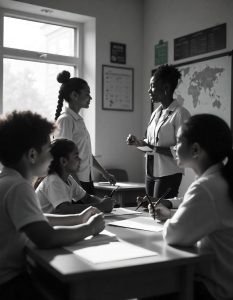Diversity and inclusion have become pivotal themes in education across Europe, reflecting the continent’s rich tapestry of cultures, languages, and experiences. As classrooms become increasingly multicultural, schools are tasked with creating environments that not only accommodate diverse student populations but also promote inclusive practices that foster equity and belonging. This article explores how schools in Europe are addressing these challenges, highlighting successful strategies, examples, and the ongoing need for improvement.
Understanding Diversity in European Classrooms
Diversity in European classrooms encompasses various dimensions, including ethnicity, language, socioeconomic status, and special educational needs. According to Eurostat, nearly 10% of the EU population is foreign-born, and many students come from immigrant families, bringing unique cultural perspectives and experiences into the classroom (Eurostat, 2021). This diversity enriches the educational experience but also requires schools to adapt their teaching methods and policies to meet the varied needs of all learners.
Strategies for Promoting Inclusion
- Culturally Responsive Teaching
Culturally responsive teaching (CRT) is an approach that recognizes and values students’ cultural backgrounds. Educators are encouraged to incorporate diverse perspectives into the curriculum, making learning more relevant and engaging for all students. For example, in the Netherlands, schools are increasingly integrating multicultural literature and history into their programs, allowing students to see themselves reflected in the content (Driessen, 2019).
- Language Support Programs
Language barriers can significantly hinder the academic success of students from non-native backgrounds. Many European countries have implemented language support programs to help these students improve their language skills. In Germany, for instance, the “Integration Through Education” initiative provides additional language classes for immigrant students, enabling them to better participate in mainstream education (Bundeszentrale für politische Bildung, 2020).
- Inclusive Policies and Legislation
National policies play a crucial role in shaping inclusive practices in schools. The European Agency for Special Needs and Inclusive Education emphasizes the importance of inclusive education frameworks that support all students, including those with disabilities. Countries like Sweden have implemented policies that promote inclusive education by ensuring that all students have access to quality education in mainstream settings (European Agency, 2021).
- Professional Development for Educators
Training teachers to understand and address diversity is essential for fostering an inclusive classroom environment. Professional development programs focusing on diversity and inclusion equip educators with the skills and knowledge needed to support diverse learners effectively. For example, in the UK, initiatives such as the “Diversity in Education” training program provide teachers with strategies to create inclusive classrooms that celebrate diversity (UK Government, 2020).
Case Studies of Successful Inclusion Practices
- Finland’s Inclusive Education Model
Finland is often cited as a leader in inclusive education. The country’s education system emphasizes individualized support for all students, regardless of their background or abilities. Finnish schools employ special education teachers who work collaboratively with classroom teachers to provide tailored support, ensuring that every student can thrive (Sahlberg, 2011).
- Spain’s Multilingual Classrooms
In Spain, particularly in regions like Catalonia, schools have adopted multilingual education models to accommodate students from diverse linguistic backgrounds. These schools offer instruction in both the regional language (Catalan) and Spanish, along with support for students who speak other languages. This approach not only helps students maintain their linguistic heritage but also promotes bilingualism and cultural exchange (Cenoz & Gorter, 2011).
- Italy’s Focus on Integration
Italy has implemented various initiatives to promote the integration of immigrant students into the education system. Programs such as “Welcome Classes” provide newcomers with intensive language support and cultural orientation, facilitating their transition into mainstream classrooms. This model has proven effective in helping students adapt and succeed academically (Fiorucci, 2019).
Challenges and Areas for Improvement
Despite significant progress, challenges remain in achieving full inclusion in European classrooms. Issues such as systemic discrimination, lack of resources, and insufficient training for educators can hinder efforts to accommodate diverse students. Additionally, the rise of anti-immigrant sentiment in some countries poses risks to inclusive practices, as schools may face pressure to prioritize the needs of native students over those from immigrant backgrounds.
Future Directions for Diversity and Inclusion in Education
As Europe continues to grapple with the complexities of diversity in its classrooms, several future directions can be identified to enhance inclusion and support for all students:
- Strengthening Community Engagement
Engaging families and communities in the educational process is vital for fostering an inclusive environment. Schools can benefit from partnerships with local organizations that support immigrant families, providing resources and guidance that help bridge cultural gaps. Initiatives that encourage parental involvement in school activities can also enhance students’ sense of belonging and community.
- Leveraging Technology for Inclusion
The rise of technology in education presents new opportunities for promoting diversity and inclusion. Digital tools can facilitate personalized learning experiences, allowing educators to tailor instruction to meet the diverse needs of their students. Online platforms can also provide resources in multiple languages, supporting non-native speakers and enhancing accessibility for students with disabilities.
- Promoting Social-Emotional Learning (SEL)
Integrating social-emotional learning into the curriculum can help students develop empathy, resilience, and interpersonal skills. SEL programs encourage students to understand and appreciate diversity, fostering a culture of respect and inclusion within the classroom. By prioritizing emotional well-being, schools can create supportive environments where all students feel valued and understood.
- Policy Advocacy and Research
Continued advocacy for inclusive education policies at the national and EU levels is essential. Policymakers must prioritize funding for programs that support diversity and inclusion, ensuring that schools have the resources needed to implement effective practices. Additionally, ongoing research into the effectiveness of various inclusion strategies can provide valuable insights that inform future educational policies.
- Cultural Competency Training for Educators
As the diversity of student populations increases, it is crucial for educators to receive training in cultural competency. Understanding the cultural backgrounds and experiences of their students can help teachers create more inclusive classrooms. Professional development programs should focus on equipping educators with the skills to address bias, promote equity, and implement culturally relevant pedagogy.
Conclusion
Diversity and inclusion in European classrooms are essential for fostering equitable educational opportunities for all students. By implementing culturally responsive teaching, language support programs, inclusive policies, and professional development for educators, schools can create environments that celebrate diversity and promote belonging. While challenges persist, the examples set by various European countries illustrate that progress is possible. Continued commitment to inclusive practices will be vital as Europe navigates an increasingly diverse future.
Diversity and inclusion in European classrooms are not merely aspirational goals; they are essential components of a quality education that prepares students for a globalized world. By embracing diverse backgrounds and promoting inclusive practices, schools can cultivate environments where all students thrive.
The journey toward full inclusion is ongoing, requiring commitment from educators, policymakers, and communities alike. Through collaborative efforts, innovative strategies, and a focus on equity, Europe can continue to lead the way in creating educational systems that reflect and celebrate the richness of its diverse populations.
References
- Bundeszentrale für politische Bildung. (2020). Integration durch Bildung. Retrieved from [Integration Through Education](https://www.bpb.de/gesellschaft/migration/)
- Cenoz, J., & Gorter, D. (2011). A holistic approach to multilingual education: The role of language in education. In Multilingualism and Language Diversity in Urban Areas (pp. 27-40). Routledge.
- Driessen, G. (2019). Diversity and Education: A Global Perspective. In The International Handbook of Diversity in Education (pp. 1-20). Springer.
- European Agency for Special Needs and Inclusive Education. (2021). Inclusive Education in Europe: A Comparative Study. Retrieved from [European Agency](https://www.european-agency.org/)
- Eurostat. (2021). Statistics on Migration and Migrant Population in the EU. Retrieved from [Eurostat](https://ec.europa.eu/eurostat/statistics-explained/index.php?title=Migration_and_migrant_population_statistics)
- Fiorucci, M. (2019). The Integration of Immigrant Students in Italy: Policies and Practices. European Journal of Education Studies, 6(3), 45-60.
- Sahlberg, P. (2011). Finnish Lessons: What Can the World Learn from Educational Change in Finland? Teachers College Press.
- UK Government. (2020). Diversity in Education: Training for Teachers. Retrieved from [UK Government](https://www.gov.uk/government/publications/diversity-in-education)
- Collaborative for Academic, Social, and Emotional Learning (CASEL). (2020). What is SEL? Retrieved from [CASEL](https://casel.org/what-is-sel/)
- European Commission. (2020). Digital Education Action Plan 2021-2027. Retrieved from [European Commission](https://ec.europa.eu/education/education-in-the-eu/digital-education-action-plan_en)
- OECD. (2020). Learning in the Time of COVID-19: The Role of Education in Responding to the Crisis. Retrieved from [OECD](https://www.oecd.org/coronavirus/policy-responses/learning-in-the-time-of-covid-19-the-role-of-education-in-responding-to-the-crisis-9b0f1c6e/)
By focusing on these future directions, European educational institutions can continue to evolve and adapt, ensuring that all students, regardless of their background, have the opportunity to succeed and contribute to society. The commitment to diversity and inclusion is not only a moral imperative but also a pathway to enriching the educational experience for everyone involved.



